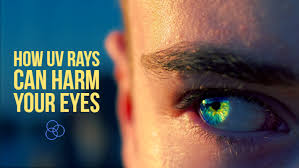
UV Rays Eye Protection
If is important to protect your eyes from UV Rays. This is something we really have to be concern about in the Summer. Ultraviolet rays are categorized as UVB, UVC, and UVA. The naked eye can’t see these rays. Your eyes can be exposed to these rays even on a cloudy day. Rays can also be reflected from the snow, water and ground.
UVB Rays are probably the rays that’s most familiar to most people. These rays are very damaging to the skin and the eyes and the skin. They can lead to skin cancer around the eyes, cataracts and macular degeneration. These rays can be very harmful to children. Children should wear sunglasses when they are outside to avoid exposure. UVA rays are always present. They are both inside and outside. These rays cause eyestrain and fatigue. People that work with computer often have problems with these types of Rays. UVC rays are the rays that cause the most damage. These rays are damaging to the environment and body. They are normally a problem in areas that have ozone depletion problems.
We also experience problems from the Blue Light. Blue Light comes from electronic devices. We experience Blue Light from phones and computers. These rays are damaging like outside UV rays. Blue filtering screens or devices in lenses can help those with early stages of macular and degeneration. Blue rays also found in overhead lighting and outdoors.
Best Way To Protect Yourself Against You UV Rays
Always be aware when the rays are most dangerous outdoors by checking the news. You can wear sun screen cream, wear sunglasses and hats. You shades should be made with UV-blocking materials. You should strive to get sun blocking materials in your shades that block 97 percent of the rays. You want glasses that give good protection around the eyes and face.
What Should Your Sunglasses Do
- Not Distort Colors
- Be comfortable To Wear
- Protect The Eyes With Lenses That Pop Out, Not In
- Reduce Glare And Filter Out 99 to 100 Percent Of UV-A Rays And UV-Radiation
- Get Contact Lenses With UV Protection
- Have Lenses That Are Gray For Proper Color Recognition
- Screen Out 75 to 90 Percent Of Visible Light
More Tips About Choosing Sunglasses For UV Rays Protection
Many misconceptions exist about the right sun protection for your eyes. Keep these tips in mind:
- Not all sunglasses block 100 percent of UV rays. If you’re unsure about the level of UV protection your sunglasses provide, take them to your eye doctor or optician for an evaluation. Many eye care professionals have instruments such as spectrophotometers that can measure the amount of visible light and UV radiation your lenses block. Almost all sunglasses block a portion of HEV rays, but some tints block more blue light than others. Blue-blocking sunglass lenses usually are bronze, copper or reddish-brown in color.
- Remember to wear sunglasses even when you’re in the shade. Although shade reduces your UV and HEV exposure to some degree, your eyes still will be exposed to UV rays reflected from buildings, roadways and other surfaces.
- Sunglasses are important especially in winter, because fresh snow can reflect 80 percent of UV rays, nearly doubling your overall exposure to solar UV radiation. If you ski or snowboard, choosing the right ski goggles is essential for adequate UV protection on the slopes.
- Even if your contact lenses block UV rays, you still need sunglasses. UV-blocking contacts shield only the part of your eye under the lens. UV rays still can damage your conjunctiva and other tissues not covered by the lens. Wearing sunglasses protects these delicate tissues and the skin around your eyes from UV damage.
- If you have dark skin and eyes, you still need to wear sunglasses. Although your dark skin may give you a lower risk of skin cancer from UV radiation, your risk of eye damage from UV and HEV rays is the same as that of someone with fair skin.
